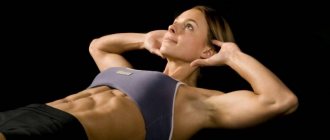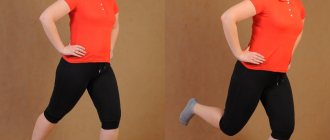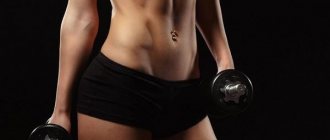✅You can make your stomach flatter and your lower abdomen tightened, as well as reduce your waistline and eliminate painful symptoms in the lower back - if you do these exercises regularly.
Who wouldn't want a flat, toned stomach? In addition, developed abdominal muscles, in addition to aesthetic appeal, are of great importance for the correct functioning of internal organs and the health of the spine, especially the lumbar region. The main mistake of people who want to lose weight in the abdominal area and gain an elegant waist is performing numerous exercises on press crunches, leg raises, and side bends. Alas, without following a diet, the opposite effect from such training is often observed and the waist circumference may even increase slightly due to muscle growth under a layer of fat.
Content
- 1 Abdominal exercises
- 2 Warm-up for the abdominals
- 3 Anatomy and morphology
- 4 Exercises 4.1 Exercises for the rectus abdominis muscles
- 4.2 Exercises for the oblique and transverse abdominal muscles
- 4.3 Combined exercises for the abdominal muscles
- 4.4 Tip
Warm-up for the abdominals[edit | edit code]
Abdominal exercises can be performed at the beginning or end of your workout. If you do them at the end of your workout, you don't need to warm up separately. Perform a warm-up set of abdominal exercises without weights if you plan to use them in the future. If you're starting your workout with abdominal exercises, perform at least one light set of crunches before moving on to more intense exercises. Read more:
Warm-up in bodybuilding
Anatomy and morphology[edit | edit code]
Superficial and deep abdominal muscles
The abdominal press consists of a very complex combination of muscles:
- Rectus abdominis muscle.
- The external oblique muscle is located on the sides of the rectus abdominis muscle.
- The internal oblique muscle is located under the external oblique muscle.
- The transverse abdominis muscle is located under the oblique abdominal muscles.
The listed muscles are part of the muscular corset.
- Abdominals in cross section
- Abdominal Press
The abdominal muscles contract at both ends. Lifting the torso primarily engages the upper abdominal muscles; Lower body lifts primarily work the lower abdominal muscles (though not exclusively; this is also true for the upper abdominal muscles).
The oblique muscles are located on both sides of the abdomen. They support the spine and play a leading role in pelvic rotation.
Unfortunately, it is much more difficult to exercise and develop the lower abdominal muscles than the upper abdominal muscles. Keep this in mind as you perform leg raises, using primarily your upper abdominal muscles. This is what makes leg raises a harder exercise than crunches.
However, the lower abdominal muscles play a major role in protecting the spine and preventing the formation of fat deposits (fat accumulates to a greater extent in the lower abdomen). Therefore, a properly designed exercise program for the abdominal muscles includes exercises not only for the upper, but also for the lower abdominal muscles.
A set of exercises for the abdominal muscles.
Exercise 1. For the upper abdominal muscles.
I.p. - lying on the mat, on your back. Hands clasp behind your head. Bend your legs at the knees and hold them hanging, almost touching the floor with your toes.
Raise your body about 30-40 degrees while straightening your legs and keeping them at the same angle. Hold this position for 3-5 seconds. Return to i.p.
Breathing technique: take a deep breath, as you exhale – a forceful movement, while holding your breath – fix the position, while inhaling – return to IP, then – deep exhale.
Exercise 2. For the abdominal muscles and inner thighs.
I.p. – lying on your back, legs bent at the knees, suspended, hands on your hips. As you exhale, raise your body 45 degrees, straightening your right leg at the same angle. We fix the position for 5-10 seconds (breath holding), return to IP. and continue the exercise, straightening the left leg.
Exercise 3. For the abdominal and leg muscles.
I.p. - lying on your back, legs closed and extended, hands clasped behind your head or lying along your body, palms down - this is an easier option, as there is additional emphasis on your hands.
Raise your closed legs at an angle of 30-45 degrees. Then, without lifting your torso from the floor, spread them apart. How can it work out for someone: from an angle of 60 degrees to 100. Fix the position for 5 seconds. Return to i.p.
Exercise 4. “Scissors.” For abdominal muscles, legs and thighs.
I.p. - the same as in the previous exercise.
Raise your closed legs 45 degrees. Perform, without lowering your legs, 10 to 20 cross swings to the sides. Once, spread your legs apart. At the count of 2-10, the maximum spread was recorded, at the count of 11, an overlap was performed. And they started again.
Depending on the angle at which you raise your legs, it depends on which groups of abdominal muscles you are currently developing: at an angle of 21-30 degrees - the lower abdominal muscles, at an angle of 45 degrees - the central abdominal muscles are worked out more, if you lift legs perpendicular to the torso, the central and upper muscles will receive greater load.
If you add this abdominal muscle strengthening exercise to your basic routine, it will allow you to work all muscle groups using 3 approaches, at angles of 25-30, 45 and 90 degrees, and can guarantee not only a firm stomach, but also thin waist.
On topic: When you pump your abs, the weight goes away
Exercise 5. “Rowing”. For the abdominal muscles, back, legs.
I.p. – sit on the mat, legs slightly bent at the knees, back straight, hands clenched into fists and lowered between the knees.
Bend back at an angle of 45 degrees, while straightening your legs at an angle of 20-30 degrees. Fix the position for 1-2 seconds, tensing all the muscles: legs, abdomen, arms. Socks are pulled out. Return to i.p.
Breathing technique: while taking a deep breath, bend back and straighten your legs. Hold your breath for 1-2 seconds when you fix the position. As you exhale, return to i.p. and draw in your stomach for 1-2 seconds, holding your breath.
Exercise 6. For the abdominal and thigh muscles.
Sit on the mat, put your arms back, tilt your torso back at an angle of 45 degrees, leaning on your hands, legs extended.
Pull your right knee toward your left shoulder, toes pointed. Lock the position. Return to i.p. and perform the exercise with your left leg.
Breathing technique: take a deep breath, as you exhale – a forceful movement; while fixing the position, hold your breath for 2-3 seconds.
Exercise 7. For the abdominal and back muscles. Variant of the yoga pose “Snake”.
I.p. – lying on your stomach, arms extended lengthwise, palms down, resting on your chin.
Taking a deep breath, you begin to slowly lift your torso, without lifting your legs and hips from the floor. The movement is performed only by the upper body. Fix the position and hold your breath for 5-10 seconds. On a slow exhale. slowly, return to IP.
Initially, you will be able to rise only 10-15 degrees, but regular performance of all exercises to strengthen the abdominal muscles will allow you to increase the angle of inclination to 25-30 degrees in a month.
You can start this exercise with an easier version: bend your elbows and place your hands on either side of your head. When rising, lean on your hands - you will bend almost perpendicular to the floor. Tighten your abdominal and back muscles for 2-5 seconds and return to the I.P.
Exercise 8. For the lateral abdominal muscles.
I.p. - lying on your back, hands clasped behind your head, legs bent at the knees, hanging.
On the count of 1, lift your torso and move your right elbow toward your left knee. Fix the position - 2-4, return to IP - 5-6. Repeat, pointing your right knee and left elbow towards each other.
Exercise 9. “Bicycle”. For abdominal muscles, thighs and legs.
The exercise is quite common, but no less effective for strengthening the abdominal and thigh muscles.
I.p. – lying on your back, arms along your body or clasped behind your head. Raise your legs perpendicularly and begin to imitate riding a bicycle. It is recommended to perform 50-100 movements. It doesn’t take much time, but not only the muscles, but also the blood vessels of the legs are strengthened, and blood circulation is regulated. This exercise is an effective prevention of varicose veins and reduces leg fatigue.
Exercise 10. Also quite famous. I call him "Pencil".
I.p. – lying on your back, arms behind your head, bent or extended. Legs are straightened, closed, toes extended. Raise your legs and start “writing” numbers from 1 to 10 with them, at least you can write words or letters - it doesn’t matter. The main thing about this exercise is that it works different muscle groups.
I didn’t even include the traditional exercise for strengthening all the abdominal muscles - full bending from a lying position, when you need to touch your knees with your forehead (hands clasped behind your head) - it is very effective and well-known.
On the subject: Why you can’t pump up your abs when you have fat
Combined with a healthy and balanced diet, a set of exercises to strengthen the abdominal muscles , performed systematically, will provide you with an ideal figure with a thin waist.
Exercises to strengthen muscles with dumbbells.
Exercises with dumbbells belong to the group of strength exercises. When they are performed, the load on all muscle groups being worked increases - this allows you to quickly increase muscle mass. Read more.
7 exercises for flexibility of the spine and neck
This complex includes exercises to strengthen the muscular system, especially the muscles of the back and cervical region. If performed regularly, you can avoid osteochondrosis and curvature of the spine. Read more
What should sportswear be like?
A good choice of sportswear is not only a good mood during training and comfort. It's also about your health. How to choose the right clothes for sports. Read more
Comprehensive body skin care.
How long we will be able to maintain beauty and youth depends on how correctly and systematically we take care of our body. Read more
Did you like the article? Share the link with your friends!
Source
Exercises[edit | edit code]
Exercises for the rectus abdominis[edit | edit code]
Anatomy of the abdominal muscles
- Bodyweight exercises:
Crunches Straight crunches - Crunches on a fitball
- Raising the body from a lying position
- Exercises with weights
Crunches with dumbbells or weight plates - Hanging leg raises with weights on legs
- Exercises in the simulator:
Crunching with body lifting on an inclined bench with dumbbells or weight plates - Raising bent legs on parallel bars
Read more:
Exercise machines for abdominal muscles
Exercises for the oblique and transverse abdominal muscles[edit | edit code]
- Bodyweight exercises:
Crunches with body rotations - Twisting with body rotation
- Side crunches
- Leg raise while lying on your side
- Hanging pelvic rotations
- V-turns
- Lying leg rotations
- Exercises with weights
Samson bends
- Exercises in the simulator
Side crunches on a crossover - Turn on the block (“woodcutter”)
- Tilts on the block
Combined exercises for the abdominal muscles[edit | edit code]
- Bodyweight Exercises:
Double Crunch - Diagonal twist
- Combined twist
- Reverse crunch on the ball
- Exercise bike
- Tackles on the ball with a turn
- Exercises with weights
Crunches with a ball - Double crunches with weights
- Exercises in the simulator:
Knee raises on a block - Variants of crunches in simulators
- Crunches in the simulator
-
Plank Abs Exercises - boat
- Exercise vacuum
Advice[edit | edit code]
(a) Normal abdominal wall with developed muscles;
(b) normal abdominal wall with developed muscles and a layer of fat; (c) abdominal wall with insufficiently developed muscles, but without a layer of fat; (d) an abdominal wall with underdeveloped muscles and a layer of fat (protruding belly) Even if you do not have excess fat, weak abdominals can cause your belly to sag. By regularly training your abdominal muscles for several weeks, you can tighten your stomach and make it flat.
If your stomach problems are caused by excess fat, abdominal training will help you tighten your stomach, even if you don't burn an ounce of fat.
The good news is that abdominal training produces results in about a month—and that's a very short period of time. First, you will tighten your muscles, then you will begin to burn fat - and every day your stomach will become flatter and your silhouette more attractive.
With regard to abdominal muscles, women usually set themselves one of two goals:
- Create a very flat stomach with as thin a layer of fat as possible.
- Create a small belly with abdominals covered in a very thin layer of fat.
Some women want to see the relief of their abdominal muscles, while others find it not quite feminine. And although these goals may seem opposite, they have one thing in common: developed abdominal muscles as the opposite of a flabby stomach. So, whatever your goal is, you will have to work hard on your abs.
Exhale vacuum exercise
1. Starting position – lying, sitting or standing (for athletes with an above-average level of physical fitness).
2. Take a deep breath through your nose, and then almost immediately release the air through your mouth, completely emptying your lungs. At the same time, pull your stomach in tightly so that the distance between your navel and lower back is as small as possible. Hold for 10-15 seconds.
3. Take a short breath, but do not rush to relax your abdominal muscles. Gradually begin to do this while exhaling, slowly returning to the starting position. You can repeat the movement from 8 to 15 times.
For more noticeable and faster results, it is recommended to supplement this basic exercise with other abdominal exercises that involve this muscle. The main training mode is static, and it is important to constantly pull in your stomach with force, otherwise the load will shift to external muscles that are more accustomed to the load.
The most famous of them is the classic plank, which uses almost the muscles of the entire body, including the deep ones. However, for this you need to strictly follow the technique of its implementation.
Muscle corset and health[edit | edit code]
When we talk about abdominal muscles, we usually have in mind a certain aesthetic image: ideally, we imagine a flat stomach without excess fat with sculpted muscles. However, nature did not provide us with these muscles for beauty.
The muscle corset performs vital functions, ensuring movement and health. Therefore, they need to be worked out not only in order to create a flat, sculpted stomach. Besides the aesthetic aspect, there are six important reasons why we should work on our abdominal muscles:
- Relieving muscle tension. At night, the lower back muscles often remain tense, as a result of which the spine does not recover. A man wakes up tired and his back hurts. A few minutes of abdominal exercise before bed is enough to relax the lower back muscles and relieve tension in the spine.
- Spine protection. The spine is supported not only by the back muscles, but also by the abdominal muscles. If the abdominal muscles are underdeveloped, this increases tension in the intervertebral discs of the spine, which increases the risk of lumbar fracture.
- Reducing the risk of developing diseases such as type 2 diabetes. Type 2 diabetes develops with age, usually as a result of the accumulation of excess fat in the abdominal area.
- Improving the condition of the gastrointestinal tract. Abdominal training improves digestion and prevents bloating and constipation.
- Improving sports performance. The abdominal muscles play an important role in all everyday activities, as well as in those sports where you need to run quickly or twist your torso. Research shows that athletes with weakened abdominal muscles are more likely to experience flank colic. Strengthening the abdominal wall is a wonderful way to solve this problem.
- Improving the condition of the cardiovascular system. Cyclic abdominal training effectively works the respiratory and cardiovascular systems. At the same time, the knee and hip joints are not subject to excessive stress.
The evolution of the modern woman[edit | edit code]
Predominant distribution of fat tissue in women
Women did not always have so much belly fat. However, a combination of hormonal birth control pills (especially those high in progesterone) and excess consumption of dietary fats and sugars (eg, soda, chocolate, bread, pasta, cakes) altered a woman's genetics. These days, more and more women have belly fat, similar to what many men have. In this case, equality clearly does not benefit women.
With the onset of menopause, decreased production of natural estrogen disrupts hormonal balance. When the level of female hormones decreases, a woman's endocrine system begins to behave like a man. As a result, the distribution of body fat is distorted: fat deposits begin to appear in the abdominal area. For this reason, as women approach menopause, they should double the intensity and volume of abdominal training to minimize the effect of fat redistribution.
Like men, women have fat deposits in the abdomen and waist, but unlike men, these areas should not be where fat accumulates.
Ineffective and dangerous abdominal exercises[edit | edit code]
Incorrect position with back arching Correct abdominal contraction (right) reduces the distance between the chest and pelvis.
Improper abdominal contraction (left) increases the distance between the chest and pelvis and also causes the lower back to arch. There are many abdominal exercises that are not only ineffective, but even dangerous for the spine. Luckily, there is an easy way to tell a good exercise from a bad one. In bad cases, muscle contraction is accompanied by arching of the back; good exercises round the back. Exercises in which you arch your lower back are not able to effectively work your abdominal muscles.
The leg is lifted by the hip flexors, not the abdominal muscles.
Ineffective exercises use the following muscles: psoas major, iliacus, and rectus femoris. You'll feel them working when the exercise causes you to arch your lower back. For example, exercises that require you to lift your legs and keep them suspended for as long as possible (such as scissors) while you lie on your back on the floor break your back. Because the abdominal muscles are attached to the pelvis and not the hips, they cannot move the legs.
These movements are not only dangerous, but also painful. Since arching the back is dangerous for the intervertebral discs of the lower back, the abdominal press strives to straighten the spine by contracting isometrically (that is, statically, without movement). Because the blood supply to that area of the body is blocked during an isometric contraction, the abdominal muscles do not receive oxygen. Impaired blood supply also prevents the removal of lactic acid from the abdominal muscles, which eventually accumulates in them in large quantities. This movement causes an intense muscle burning sensation. In addition, it is dangerous and reduces athletic performance. It must also be remembered that isometric contraction does not help strengthen the abdominal muscles and burn fat.
Is it possible to pump up your abs at home without going to the gym?
Indeed, to see the cubes, you need to get rid of the fat layer and this is not so easy. You can perform a training complex for years, but still not see sculpted abs, but you can achieve good results in a month. Sweets, flour products and many other simple carbohydrates will cover the abdominal muscles with a layer of fat, and no matter how hard you train your abs, there will be no effect.
When training at home, you need to start by introducing proper and healthy foods into your regimen. Moreover, each product must be taken on time, without leading the body to starvation and without slowing down the metabolism.
Fortunately, you don't need any special machines or equipment to train. Classes can be done using your own weight. All you need is a mat; you can add, if desired, special weighted cuffs to increase the load and pump up your abs.
Since the body can get used to each load, it is necessary to use additional weights or the help of a partner to complicate the exercise. At home, you can use your imagination by taking bottles of water in your hands instead of dumbbells, and this will be very effective. Therefore, it is quite possible to do an abdominal workout at home without spending much time. But remember, the rest of the time is spent monitoring nutrition.
How to increase the natural curve of the lower back[edit | edit code]
Psoas Major Action During Back Arching
Many men believe that a visible arch in a woman's lower back is sexier than a flat lower back. The lumbar curve emphasizes the shape of the buttocks and pulls the shoulders back, emphasizing the breasts, which is what many women strive for.
The goals we describe in this book (rounding your butt, pushing your shoulders back, creating a flat stomach) will also improve your health. Increasing the natural curve of the lower back is quite simple, but there is also a downside: increasing unwanted pressure on the intervertebral discs of the lower back.
Powerful hip flexors (the psoas major) increase the natural curve of the lower back, pushing the intervertebral discs forward. This places excess pressure on the back of the lumbar vertebrae, which can lead to pain and damage to the vertebrae due to compression and misalignment.
It's up to you to decide if you want to go this route. If you decide to do this, we recommend doing, in particular, an exercise to develop the strength of the lower back muscles to reduce excess pressure on the intervertebral discs.
Whatever your choice, in this section we will describe techniques for performing abdominal exercises that will allow you to:
- maintain your back in a natural position;
- increase the natural curve of the lower back.
Exercise "vacuum" while inhaling
Technique:
1. Stand straight, feet shoulder-width apart, hands on hips. This is your starting position.
2.Now inhale the maximum amount of air, drawing in your stomach as much as possible, and hold in this position. Imagine that your stomach is touching your spine.
3. One isometric contraction lasts 20-40 seconds. While doing this, try to breathe in a normal manner.
4.Then exhale and return to the starting position.











